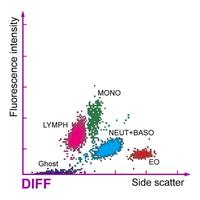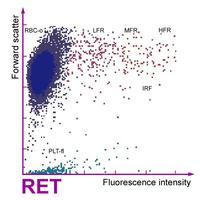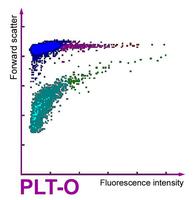In the reticulocyte channel of the haematology analysers SYSMEX XE-5000, XE-2100 and XT-2000i all blood cells are stained with a fluorescent dye and classified by fluorescence intensity (largely correlating with the content of nucleic acids) and forward scatter. The forward scatter signal reflects the contents of a cell (for example the haemoglobin content in red blood cells) as well as the cell size. Mature erythrocytes do not contain RNA and can therefore be found in the upper left of the scattergram (RBC-O, blue). The reticulocytes contain different amounts of RNA depending on their maturity status and can be classified accordingly into 'low fluorescent reticulocytes' (LFR, purple) and ‘medium’ or 'high fluorescent reticulocytes' (MFR and HFR, red). MFR and HFR are additionally reported as the combined 'immature reticulocyte fraction' (IRF). As an immediate sign of enhanced erythropoiesis in the bone marrow an increase of the HFR population is observed. The comparably small platelets are located at the bottom of the scattergram (turquoise population). Leukocytes are usually located outside the displayed scattergram.
Moreover, the haemoglobin content of the reticulocytes (RET-He) can be assessed. It reflects the iron supply in the bone marrow of the patient and is therefore of great value for the differential diagnosis of anaemia, therapeutic decisions, and therapy monitoring. On the XE-2100 and the XT-2000i a dedicated software (RET MASTER) is required to measure RET-He. In addition, the software allows to separately count schistocytes. On the XE-5000 these features are integrated.





